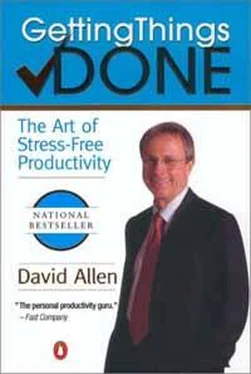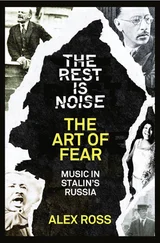When you're not sure where you're going, you'll never know when enough is enough.
I'm blending the three uppermost levels together here because situations often can't easily be pigeonholed into one or another of these categories. Also, since Getting Things Done is more about the art of implementation than about how to define goals and vision, I won't offer a rigorous examination here. But by its very nature this investigation can broach potentially deep and complex arenas, which could include business strategy, organization development, career planning, and life direction and values.
For our purposes, the focus is on capturing what motivators exist for you in current reality that determine the inventory of what your work actually is, right now. Whether your directions and goals should be changed—based on deeper thinking, analysis, and intuition—could be another discussion. Even so, there are probably some things you can identify right now that can help you get current in your own thinking about your work and what's important in it.
If you were to intuitively frame a picture of what you think you might be doing twelve to eighteen months from now, or what the nature of your job will look like at that point, what would that trigger? At this level, which is subtler, there may be things person-ally you need to let go of, and people and systems that may need to be developed to allow the transition. And as the job itself is a moving target, given the shifting sands of the professional world these days, there may need to be projects defined to ensure viability of the outputs in your area.
In the personal arena, this is where you would want to consider things like: "My career is going to stagnate unless I assert my own goals more specifically to my boss (or my boss's boss)." Or "What new things are my children going to be doing next year, and what do I need to do differently because of that?" Or "What preparation do I need to ensure that I can deal with this health problem we've just uncovered?"
Through a longer scope you might assess: How is your career going? How is your personal life moving along? What is your organization doing relative to changes in the environment, and what impact does that have on you? These are the one-to-five-year-horizon questions that, when I ask them, elicit different and important kinds of answers from everyone.
Not long ago I coached someone in a large international bank who, after a few months of implementing this methodology and getting control of his day-to-day inventory of work, decided the time was right to invest in his own start-up high-tech firm. The thought had been too intimidating for him to address initially, but working from the "runway level" up made it much more accessible and a natural consequence of thinking at this horizon.
If you're involved in anything that has a future of longer than a year (marriage, kids, a career, a company, an art form), you would do well to think about what you might need to be doing to man-age things along that vector.
Questions to ask yourself here are:
• What are the longer-term goals and objectives in my organization, and what projects do I need to have in place related to them to fulfill my responsibilities?
• What longer-term goals and objectives have I set for myself, and what projects do I need to have in place to make them happen?
• What other significant things are happening that could affect my options about what you I'm doing?
Here are some examples of the kinds of issues that show up at this level of conversation:
• The changing nature of your job, given the shifting priorities of the company. Instead of managing the production of your own training programs in-house, you're going to outsource them to vendors.
• The direction in which you feel you need to move in your career. You see yourself doing a different kind of job a year from now, and you need to make a transition out of the one you have while exploring the options for a transfer or promotion.
• The organization direction, given globalization and expansion. You see a lot of major international travel looming on the horizon for you, and given your life-style preferences, you need to consider how to readjust your career plans.
• Life-style preferences and changing needs. As your kids get older, your need to be at home with them is diminishing, and your interest in investment and retirement planning is growing.
At the topmost level of thinking, you'll need to ask some of the ultimate questions. Why does your company exist? Why do you exist? What is the core DNA of your existence, personally and/or organizationally, that drives your choices. This is the "big picture" stuff with which hundreds of books and gurus and models are devoted to helping you grapple.
"Why?": this is the great question with which we all struggle.
You can have all the other levels of your life and work ship-shape, defined, and organized to a T. Still, if you're the slightest bit off course in terms of what at the deepest level you want or are called to be doing, you're going to be uncomfortable.
Getting Priority Thinking Off Your Mind
Take at least a few minutes, if you haven't already done so, to jot down some informal notes about things that occurred to you while you've been reading this chapter. Whatever popped into your mind at these more elevated levels of your inner radar, write it down and get it out of your head.
Then process those notes. Decide whether what you wrote down is something you really want to move on or not. If not, throw the note away, or put it on a "Someday/Maybe" list or in a folder called "Dreams and Goals I Might Get Around to at Some Point." Perhaps you want to continue accumulating more of this kind of future thinking and would like to do the exercise with more formality—for example, by drafting a new business plan with your partners, designing and writing out your idea of a dream life with your spouse, creating a more specific career map for the next three years for yourself, or just getting a personal coach who can lead you through those discussions and thought processes. If so, put that outcome on your "Projects" list, and decide the next action. Then do it, hand it off to get done, or put the action reminder on the appropriate list.
With that done, you may want to turn your focus to develop-mental thinking about specific projects that have been identified but not fleshed out as fully as you'd like. You'll want to ensure that you're set up for that kind of "vertical" processing.
10. Getting Projects Under Control
CHAPTERS 4 THROUGH 9 have given you all the tricks and methods you need to clear your head and make intuitive choices about what to do when. That's the horizontal level—what needs your attention and action across the horizontal landscape of your life. The last piece of the puzzle is the vertical level—the digging deep and pie-in-the-sky thinking that can leverage your creative brainpower. That gets us back to refining and energizing our project planning.
The Need for More Informal Planning
After years of working with thousands of professionals down in the trenches, I can safely say that virtually all of us could be doing more planning, more informally and more often, about our projects and our lives. And if we did, it would relieve a lot of pressure on our psyches and produce an enormous amount of creative out-put with minimal effort.
I've discovered that the biggest improvement opportunity in planning does not consist of techniques for the highly elaborate and complex kinds of project organizing that professional project managers sometimes use (like GANTT charts). Most of the people who need those already have them, or at least have access to the training and software required to learn about them. The real need is to capture and utilize more of the creative, proactive thinking we do—or could do.
Читать дальше











